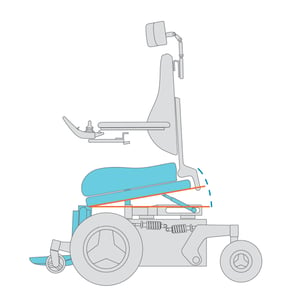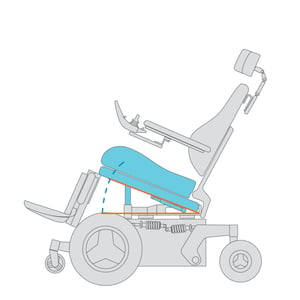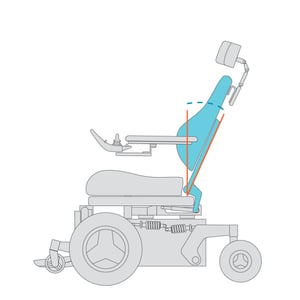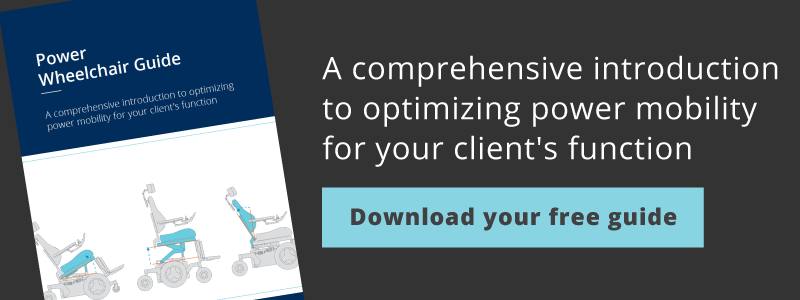As we continue working our way through power wheelchair topics our focus turns to the different power seat functions available on the market today. Simply put, power seat functions are the different positions a power wheelchair can achieve. These different positions can be important to perform functional tasks during the day (e.g., seat elevation for reaching items) and/or they can be important to prevent medical complications (e.g., posterior tilt and recline for skin protection). Today we're taking a closer look at power tilt and power recline.
Power Tilt
| Definitions | Clinical benefits may include |
Anterior Tilt
|
Assist with managing tone and abnormal reflexes, which otherwise could interfere with function |
|
Lower front seat-to-floor height, decreasing the limitation of getting as close to and under a surface as possible, due to the position of the lower extremities |
|
|
Assist with functional reach, increasing functional independence with performing mobility-related ADLs, including self-care, hygiene, cooking, cleaning, laundry, and much more |
|
|
May help aid in digestion and speech production |
|
|
May reduce risk of upper extremity injury associated with lateral and overhead reaching |
|
Posterior Tilt
|
Used for pressure relief. A minimum of 45° of posterior tilt (for most people) redistributes pressure away from the seat surface, to the back and head support |
|
Posterior tilt can provide a gravity assisted position for individuals with limited trunk control, helping them maintain a more upright posture throughout the day |
|
|
Use of posterior tilt when navigating down ramps/curb cuts can aid in postural stability of the end user |
|
|
Since seat to back support angle remains constant, less of a likelihood of losing access to drive control or orientation of postural supports to body (e.g., lateral trunk supports, arm supports, head support) |
|
Power Recline
| Definitions | Clinical benefits may include |
|
Power recline "allows the back support to pivot posteriorly, increasing the seat to back support angle"
|
Increasing the seat to back support angle can provide postural stability for clients presenting with trunk weakness |
|
A full recline in conjunction with elevating legrests may allow for toileting and peri care to be done in the wheelchair, reducing transfers during the day |
|
|
Use of recline may help manage spasticity/tone |
|
|
When combined with tilt, recline provides additional pressure relief. For some, a combination of both tilt and recline may be required for an adequate pressure relief. |
|
* Considerations with recline:
|
You can see the multiple implications of power tilt and recline and how these seat functions can be used to reach daily goals and manage clinical needs. They should be considered for individuals who have a condition that affects their ability to independently weight shift. Join us next time in our power blog series as we work our way through power seat functions.
 Stacey Mullis, OTR/ATP
Stacey Mullis, OTR/ATP
Director of Clinical Marketing
Stacey serves as Director of Clinical Marketing for Permobil. A practicing OTR for over 20 years, she has experience in school-based pediatrics, inpatient rehabilitation, long term care, and home health. With her interest in wheelchair seating and positioning, Stacey engaged the challenges of providing appropriate seating in various clinical settings. She now uses this experience to develop programs and resources to educate clinicians on the principles of seating and wheeled mobility. She is passionate about equipping clinicians and through her previous role as Director of Clinical Education with Comfort Company and now with Permobil she has taught nationally and internationally to increase therapist capacity in this specialty area. Mullis graduated from Western University in London, Ontario, Canada with a BA Linguistics and BSc Occupational Therapy. She is a member of the NCOTA, CTF Executive Board, NRRTs, RESNA, and AOTA.
 Angela Regier, OTD, OTR/L, ATP/SMS
Angela Regier, OTD, OTR/L, ATP/SMS
Clinical Education Manager
Angela Regier, OTD, OTR/L, ATP received her doctorate of occupational therapy from Creighton University in 2007 and is a RESNA-certified assistive technology professional. Regier joined Permobil in 2017 as a Clinical Education Manager for the western region. Prior to joining Permobil, Regier was at Craig Hospital in Englewood, Colorado where her career focused on inpatient and outpatient spinal cord injury rehabilitation. Prior to leaving Craig Hospital, she was supervisor of the Wheelchair Seating and Mobility Clinic where she provided comprehensive seating and mobility interventions for individuals with acquired brain and spinal cord injury. Regier has published and speaks on the topic of seating and mobility for acquired brain injury and spinal cord injury. She has also served as an adjunct faculty for the Creighton University Entry-Level Distance OTD Program (Regis) in Denver, Colorado.




